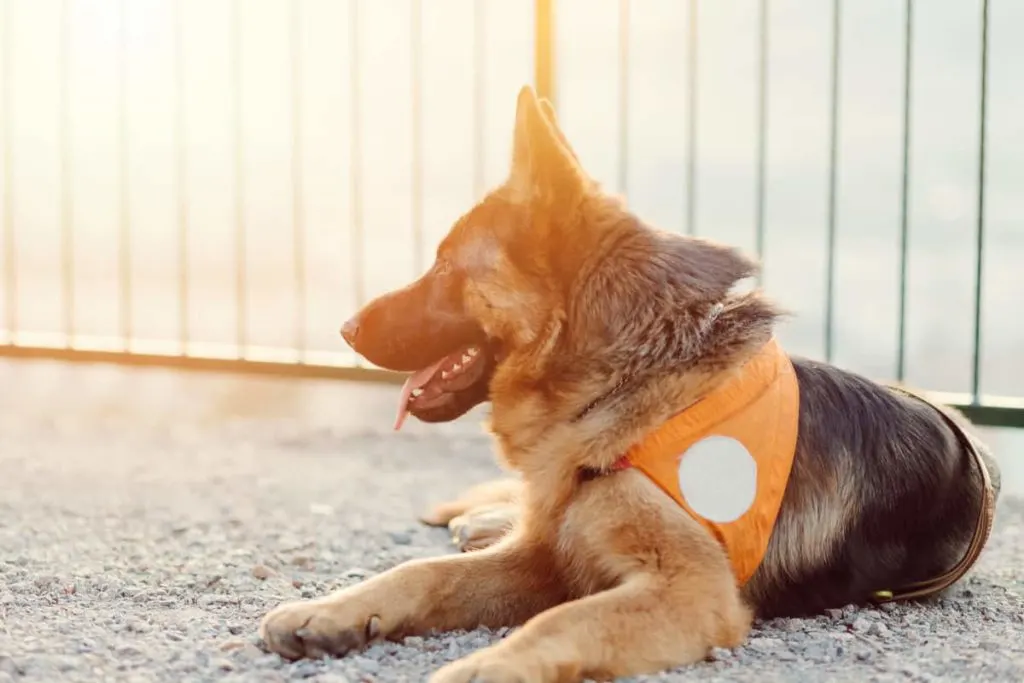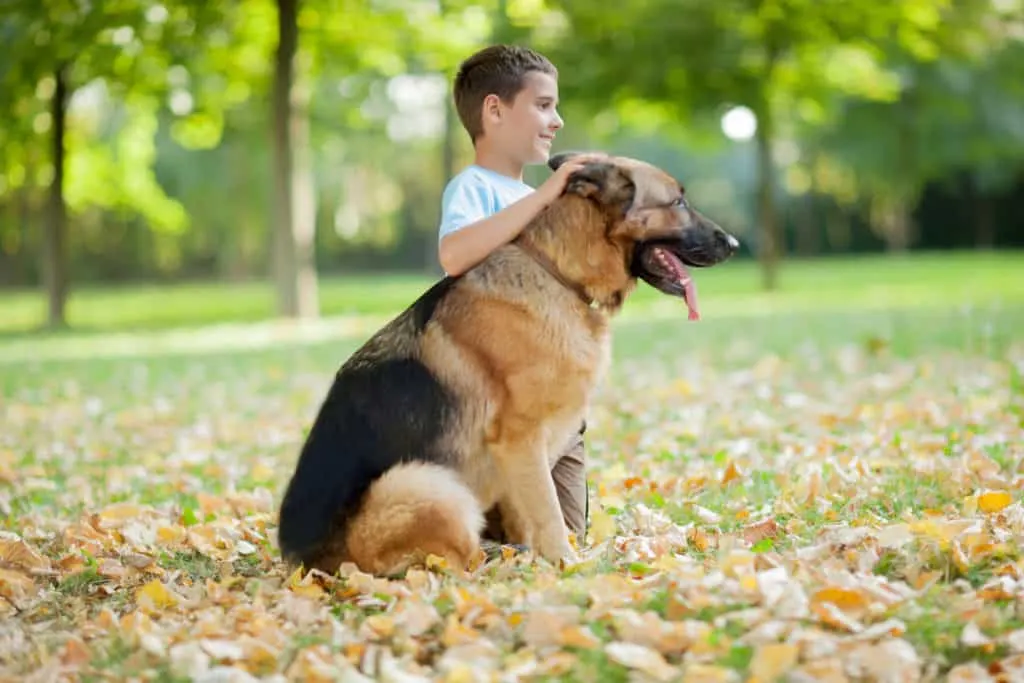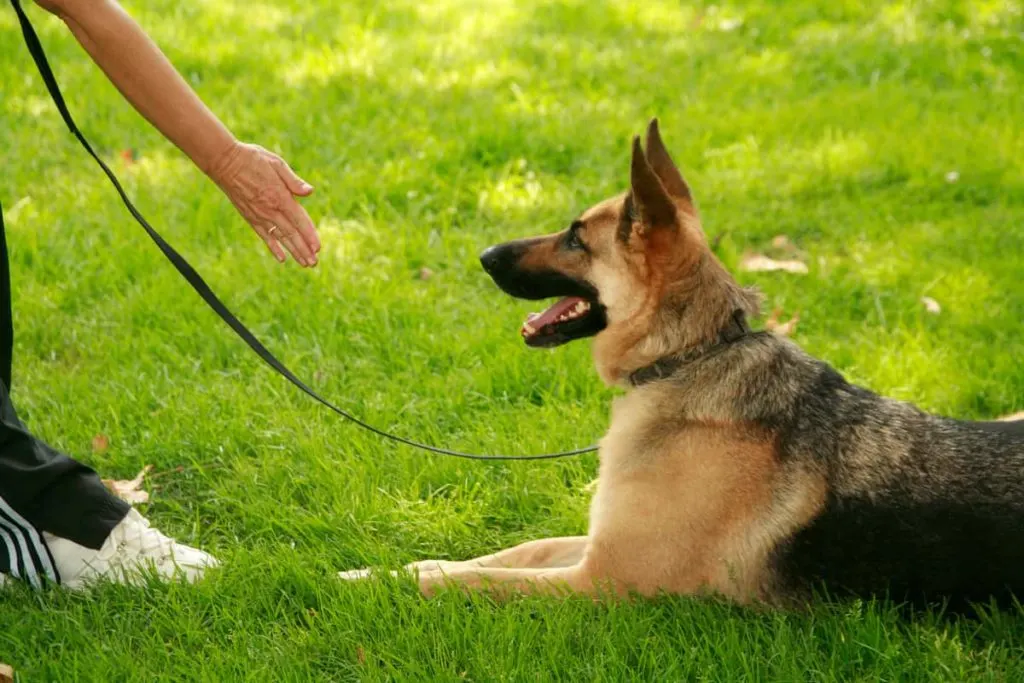
You have most likely seen a German Shepherd accompanying or leading someone with a disability. These dogs are more than just companions, they are actually serving a very vital role in that person’s life as a service dog.
German Shepherds are good service dogs because they are loyal, even-tempered, highly intelligent, and easy to train. These characteristics allow them to meet the physical, emotional, and problem-solving needs of their owners.
In this article, we will take an in-depth look at why GSDs make for great service dogs, as well as the roles that service dogs provide.
Listed below are some of the reasons that GSDs make great service dogs:
- Adaptable: German Shepherds are able to function well and adapt to new environments very quickly.
- Large size and strength: GSD’s have a large and strong stature. Many disabled people require physical assistance with as balancing or even getting back on their feet after an event like a seizure. A GSD has the strength and natural willingness to assist with situations such as this.
- Highly active: GSDs do not tire easily. They are always in search of something to do or a task to perform.
- They crave responsibility: The more responsibilities that you put in front of a GSD, the more driven they are to handle them.
- Hard workers: GSDs thrive as working dogs, as this is what they were bred for. In fact, if a GSD is not doing an activity that it can equate with work of some sort, they may actually develop behavioral problems. They need to work.
- Eager to please: Nothing makes gives a GSD more satisfaction than pleasing its owner. Just ask any GSD owner.
- Even-tempered: When properly trained, a GSD is capable of restraining itself and ignoring distractions very well. This is ideal for rendering assistance in social situations.
- Protective: GSDs are by nature very protective of their owners. A properly trained GSD will understand when a real threat exists and went to stand down. But its instinct is to protect and care for its owner, which is exactly what a service dog is intended for.
- Loyal: Even an untrained German Shepherd is reluctant to leave its owner’s side. If a person is enduring a physical or emotional hardship, a GSD will naturally endure it with that person. This is very reassuring to the person in need of assistance.
- Keen sense of smell: GSDs have a highly evolved sense of smell. They are used to detect explosives and track down people. In a service dog capacity, this sense of smell is used to detect low blood sugar in diabetics. There is even evidence of GSDs being able to sniff out cancer.
Click Here to Jump to a Section
What is a service dog?
A service dog is defined by the Americans with Disabilities Act as “dogs that are individually trained to do work or perform tasks for people with disabilities.”
These disabilities include:
- Visual impairments
- Hearing impairments
- Mental impairments
- Mobility impairments
- Diabetes
- Seizures
How do service dogs actually help people with these disabilities?
“Service dog” may be an umbrella term for dogs that help people with disabilities, but service dogs are actually trained on an individual basis to address specific disabilities.
Let’s now take a closer look at what these disabilities are and how service dogs assist with them.
Visual impairments
You have probably heard the term “guide dog.” Guide dogs are trained to assist people who are visually impaired or blind to navigate their way around obstacles.
This allows them much more functionality in their day-to-day life then they would otherwise be able to achieve on their own. However, the service that guide dogs provide is largely misunderstood.
Most people think that a guide dog just leads a person around wherever they need to go. This is not the case. In order for a guide dog to successfully perform its intended function, it is necessary for the dog to be guided or directed by the visually impaired person.
A guide dog is not trained to choose a route or to get to a destination, nor is it trained to read traffic lights. (While dogs are not color blind, they do not see color in the same way that we do, and they cannot read traffic lights).
A guide dog’s primary role is to safely navigate around people and obstacles in order to reach the destination. The dog will be on the lookout for obstacles like stairs, curbs, and obstructions in its path.
For example, if a visually impaired person wants to cross the street, they will use their hearing to gauge whether or not there’s traffic coming. If they feel that there is no traffic coming they may give the dog a verbal cue like “forward,” or they might point with their hand in the direction they want to go.
If it is safe to proceed, the guide dog will lead the way. However, if it is unsafe to proceed, the dog will not move. This is known as “intelligent disobedience.”
Intelligent disobedience is defined as “where a service animal trained to help a disabled person goes directly against the owner’s instructions in an effort to make a better decision”
Hearing impairments
Some service dogs are trained to help the hearing impaired or deaf. They do so by physically alerting their owner to common everyday sounds that most of us take for granted. They alert to sounds like:
- doorbells
- knocks on a door
- smoke alarms
- crying children
- telephones ringing
- alarm clocks
The service dog will physically alert its owner by gently nudging or pawing at them to get their attention. Once the dog has successfully alerted the owner to a sound, it is trained to then lead its owner to the source of that sound.
They are also trained to avoid alerting to a great number of sounds that we all hear in our day-to-day lives. A helicopter flying overhead, an ambulance or police siren, a lawnmower in the distance – a service dog is trained to ignore all of these types of sounds and instead to focus on specific ones that are most useful in assisting its owner.
Mental impairments
A service dog that is trained to help its owner with a mental disability is called a psychiatric service dog. Some of the impairments that these dogs are trained to assist are:
- PTSD (Post-Traumatic Stress Disorder)
- Schizophrenia
- Bipolar disorder
- Depression
- Anxiety
- OCD (Obsessive Compulsive Disorder)
It’s important to note the distinction between a psychiatric service dog and an emotional support dog. These two are not the same thing.
Emotional support dogs provide their owners with affection and companionship if they are suffering from an emotional condition such as depression. They are often assigned to people as a part of a treatment program. They are not trained to perform any specific tasks.
Psychiatric service dogs are permitted more access than emotional support dogs in the eyes of the law.
Depending on the person’s disability, a psychiatric service dog may perform a variety of functions.
For example, a person who experiences PTSD may have chronic nightmares. The dog will be trained to recognize these, and will gently wake its owner when the dog senses that they are having a nightmare.
In another instance a person may have a psychiatric disorder which causes them to self-harm, perhaps inflicting injury on themselves by repetitively hitting or picking at themselves. The dog is trained to spot these repetitive behaviors and intervene.
While the dog cannot physically stop the owner from performing an act, it can bark or paw at the owner who may be otherwise unaware of what is happening.
In the event that the owner has a mental impairment such as Alzheimer’s or dementia which causes them to forget things, the dog can remind them to take their medications, to eat their meals on time, or assist in reminding them about day-to-day tasks such as hygiene and grooming.
Mobility impairments
A service dog that is trained to assist people with mobility impairments will carry out specific tasks that the owner is unable to do by themselves. They can do things like open and close doors, they can turn light switches on and off, or find other people in the house when needed.
These dogs can also help someone with a mobility impairment to walk. While they are not intended as a substitute for a walker or a cane, they can be used for leverage and balance by the disabled person.
Service dogs for diabetics
It may surprise you to find out how a service dog that is trained to assist diabetics actually works. A diabetic person may not experience the same symptoms that most people do when their blood sugar is low.
A non-diabetic person will feel sweaty or shaky or anxious when their blood sugar is low, but they can recognize it through these feelings.
A diabetic may experience hypoglycemic unawareness. What this means is that their body does not trigger epinephrine which causes the symptoms that a normal person feels. So they remain unaware that their blood sugar is low.
A service dog is able to pick up on this through scent. All people emit the same scent from their breath when their blood sugar is low. The dog picks up on this and alerts the owner.
The owner still needs to check their blood sugar regularly, but these dogs provide an extra layer of safety for them. Hypoglycemia unawareness can be fatal, so these dogs play a very real role in saving people’s lives.
Seizures

Service dogs can also be trained to assist people with epilepsy either when they are showing the warning signs of a seizure or when they do actually have a seizure. They are trained to respond in a number of ways.
Some of these responses include:
- Activating a Life Alert device
- Retrieving a telephone
- Physically stimulating the person who is having a seizure
- Acting as a barrier between the person having a seizure and the floor to prevent injury
- Lying next to the person having a seizure to prevent injury
- Helping a person back on their feet after a seizure
Can my dog qualify as a service dog?
Certification of a service dog is not required in the United States. This is actually a great benefit to those who need them.
This is because it allows people to train their own dogs as service dogs as opposed to making them go through a certification program which may limit the access of many people without the financial means to acquire a service dog.
Under the ADA, there is no certification required to be presented to demonstrate that a dog is a service dog. And beware of any place that sells you a certification for a service dog. These are not recognized by the Ada as proof that the animal is a service dog.
Even though there is no required certification for service dogs in the United States, there are standards set forth by The International Association of Assistance Dog Partners (IAADP).
Because there was a large number of disabled individuals in need of assistance dogs who did not have any understanding of the training or guidance to give a dog, this organization developed what is called the Minimum Set of Training Standards for Public Access.
This set of standards is widely used and recognized as authoritative in terms of certifying whether or not a dog is prepared to be a service dog. Under these standards, a dog should at a minimum be able to display the following social behavior skills:
No aggressive behavior toward people or other animals – no biting, snapping, snarling, growling or lunging and barking at them when working off your property.
No soliciting food or petting from other people while on duty.
No sniffing merchandise or people or intruding into another dog’s space while on duty.
Socialize to tolerate strange sights, sounds, odors etc. in a wide variety of public settings.
Ignores food on the floor or dropped in the dog’s vicinity while working outside the home.
Works calmly on leash. No unruly behavior or unnecessary vocalizations in public settings.
No urinating or defecating in public unless given a specific command or signal to toilet in an appropriate place.
IAADP Minimum Standards for Public Access
And under IAADP’s standards, it’s not only the service dog that needs to demonstrate certain abilities. Service dogs are part of a two-part team, their counterpart being their handler. Under IAADP, the handler should be able to demonstrate that they can at a minimum:
( 1 ) safely load and unload the dog from a vehicle; ( 2 ) enter a public place without losing control of the dog; ( 3 ) to recover the leash if accidently dropped, and ( 4 ) to cope calmly with an access problem if an employee or customer questions the individual’s right to bring a dog into that establishment.
IAADP Minimum Standards for Public Access
IAADP also recommends:
- A minimum of 120 hours of schooling over a period of at least 6 months.
- At least 30 hours devoted specifically to working in public places.
Service dog training
Service dog training is far beyond that of simple obedience training for a dog. It’s a long process and requires a lot of commitment from both the dog’s handler and the dog. So the dog must have a very calm demeanor and patient temperament.
There are a number of organizations throughout the country and the world that train service dogs specifically for a particular task.
For example, there are foundations and organizations devoted specifically to the raising and training of service dogs for Alzheimer’s, diabetes, epilepsy, as well as a number of other disabilities.
Each organization has a very high set of standards that cater to the type of disability that the dog is trained to deal with.
Can I train a service dog myself?

The short answer here is yes. You can most certainly train a service dog yourself.
But before deciding to undergo this process, it’s important that you understand some fundamentals about the training as well as the time and work commitment involved.
Often times it may seem like a great idea to train your dog yourself to do this. But it’s important to understand your limits. Being overly ambitious in this scenario is not a good idea.
A service dog must be trained and have the ability to precisely execute the task that is trained for each and every time. No exceptions.
While some service dogs make life more accessible and convenient for their owners, others, as discussed above, are there for the specific task of preventing injury and saving lives.
So if you are not able to follow through entirely with the training process, it is wise to enlist the help of a professional trainer. A poorly trained service dog is no good to anybody and can be a detriment to lives.
Just be aware of the commitments involved in training your dog to be a service dog on your own. It’s absolutely possible and a great choice if you have the time and are willing to put forth the effort. Otherwise, it is highly advised to seek the help of a professional trainer.
Even if your dog is not trained entirely by a professional, you can work with a professional alongside you to guide you through the process. This will bridge the gap between you having to do everything yourself and having somebody else do all of the work for you.
How much does it cost to have a service dog trained?
Having a service dog professionally trained is not cheap by most any standard. Training costs vary widely and are largely dependent on the specific role that the dog is being trained for.
But the cost can be between $40,000 and $60,000 per dog. This is according to 4 Paws for Ability. The cost includes medical care, food, and equipment for training.
Thankfully, most people who have service dogs will have received financial assistance in acquiring them. This assistance comes in the form of Grants.
As mentioned above, there a number of not-for-profit organizations dedicated to the training of service dogs for a specific need. These organizations are funded by grants and donations, thus making it possible for many people in need of service dogs to receive them for free.
Someone is still paying for the dog, but thankfully because of the generosity and understanding of many people, these dogs are available to those who most need them for free. Though there may be long waiting lists because the demand for service dogs far exceeds the supply.
How can you get involved?

You can get involved if you choose to raise a service dog puppy. This is a huge commitment, but it’s also a very useful way to spend your time.
Many service dog organizations count on volunteers to raise their dogs. And it is a very rewarding undertaking. However, the dog will inevitably have to go to a person in need of its service.
So you have to be willing to only have that dog is a part of your life for a period of time until you have to say goodbye. This is often too much for someone to handle after they have become attached to an animal. So it does require a very specific type of person for this type of work.
If you choose to volunteer to train a puppy for service dog work, most organizations will require you to agree to terms similar to those listed below:
- The puppy will be the only puppy in the house. Other dogs may be approved, but there is likely only 1 puppy allowed.
- You will submit weekly or monthly reports on the puppy’s progress.
- You will attend specified obedience classes with the puppy.
- You will pay for all of the puppy’s living expenses including, food and veterinary costs.
- You will feed the puppy a specific diet.
- You will keep the puppy indoors and provide a crate or kennel for it.
- You will provide ample socialization opportunities to the puppy.
- You will walk the puppy on a leash only and supervise it at all times.
- YOU WILL AGREE TO RETURN THE PUPPY AT THE END OF ITS TRAINING OR BEFORE THAT IF REQUESTED!
There are a number of organizations throughout the United States that accept applications from volunteers to train puppies for service dog work. Hero Dogs is just one organization of many, so it’s a good idea to conduct a search in your locality:
Can my dog be of use and still be mine?
Thankfully, the answer to this is yes. You can put your dog to good use as a therapy dog.
A therapy dog is not trained to perform a specific function, so they don’t qualify as a service animal under the ADA. They are used to provide comfort to those in need of it, simply by being with them.
These dogs are used in a wide range of places, and they go with their owners to a location to provide therapy.
Places therapy dogs visit include:
- schools
- nursing homes
- hospitals
- hospices
- disaster areas
- mental health institutions
- homes of people with Autism or anxiety disorders
There are a number of organizations that will certify your dog as a therapy dog. The only requirements are that the dog can understand and follow basic cues, it must be well-tempered, able to work well in different surroundings, and able to avoid distractions.
While there are a number of organizations that will certify for this, it’s a good idea to go through the American Kennel Club. They have a long-standing certificate call the American Kennel Club Canine Good Citizen.
This is the most nationally recognized certificate for a high standard of dog behavior.
Final Thoughts
So now you’ve learned all about service dogs, and you understand why German Shepherds, simply by being German Shepherds, are incredibly well suited to do this work. Many qualities that are natural to a German Shepherd are extremely valuable in assisting people with disabilities.
Perhaps now maybe give some thought to training a service dog yourself. But if you want to avoid the eventuality that you will have to give the dog away, consider getting your German Shepherd certified for therapy work.
Alternatively, if you don’t yet own a German Shepherd, consider getting one. Not only will the German Shepherd you get be a wonderful addition to your life, it can brighten the lives of many others.
